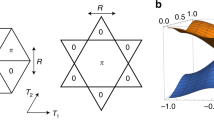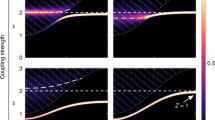Abstract
Physics is said to be universal when it emerges regardless of the underlying microscopic details. A prominent example is the Efimov effect, which predicts the emergence of an infinite tower of three-body bound states obeying discrete scale invariance when the particles interact resonantly. Because of its universality and peculiarity, the Efimov effect has been the subject of extensive research in chemical, atomic, nuclear and particle physics for decades. Here we employ an anisotropic Heisenberg model to show that collective excitations in quantum magnets (magnons) also exhibit the Efimov effect. We locate anisotropy-induced two-magnon resonances, compute binding energies of three magnons and find that they fit into the universal scaling law. We propose several approaches to experimentally realize the Efimov effect in quantum magnets, where the emergent Efimov states of magnons can be observed with commonly used spectroscopic measurements. Our study thus opens up new avenues for universal few-body physics in condensed matter systems.
This is a preview of subscription content, access via your institution
Access options
Subscribe to this journal
Receive 12 print issues and online access
$209.00 per year
only $17.42 per issue
Buy this article
- Purchase on Springer Link
- Instant access to full article PDF
Prices may be subject to local taxes which are calculated during checkout





Similar content being viewed by others
References
Fisher, M. E. Renormalization group theory: Its basis and formulation in statistical physics. Rev. Mod. Phys. 70, 653–681 (1998).
Efimov, V. Energy levels arising from resonant two-body forces in a three-body system. Phys. Lett. B 33, 563–564 (1970).
Nielsen, E., Fedorov, D. V., Jensen, A. S. & Garrido, E. The three-body problem with short-range interactions. Phys. Rep. 347, 373–459 (2001).
Braaten, E. & Hammer, H-W. Universality in few-body systems with large scattering length. Phys. Rep. 428, 259–390 (2006).
Kraemer, T. et al. Evidence for Efimov quantum states in an ultracold gas of caesium atoms. Nature 440, 315–318 (2006).
Date, M. & Motokawa, M. Spin-cluster resonance in CoCl2·2H2O. Phys. Rev. Lett. 16, 1111–1114 (1966).
Date, M. & Motokawa, M. Spin-cluster resonance in the Ising spin system. J. Phys. Soc. Jpn 24, 41–50 (1968).
Torrance, J. B. Jr & Tinkham, M. Magnon bound states in anisotropic linear chains. Phys. Rev. 187, 587–594 (1969).
Torrance, J. B. Jr & Tinkham, M. Excitation of multiple-magnon bound states in CoCl2·2H2O. Phys. Rev. 187, 595–606 (1969).
Nicoli, D. F. & Tinkham, M. Far-infrared laser spectroscopy of the linear Ising system CoCl2·2H2O. Phys. Rev. B 9, 3126–3140 (1974).
Van Vlimmeren, Q. A. G. & de Jonge, W. J. M. Spin-cluster resonance in the pseudo-one-dimensional canted Ising antiferromagnet RbFeCl3·2H2O. Phys. Rev. B 19, 1503–1514 (1979).
Van Vlimmeren, Q. A. G. et al. Spin-cluster excitations in RbFeCl3·2H2O. Phys. Rev. B 21, 3005–3014 (1980).
Hoogerbeets, R., van Duyneveldt, A. J., Phaff, A. C., Swuste, C. H. W. & de Jonge, W. J. M. Evidence for magnon bound-state excitations in the quantum chain system (C6H11NH3)CuCl3 . J. Phys. C 17, 2595–2608 (1984).
Nijhof, E. J., van der Vlist, H., Puértolas, J. A. & Gerritsma, G. J. Magnetism in the linear-chain antiferromagnet RbCoCl3·2H2O studied by dynamic susceptibility and electron-spin resonance. Phys. Rev. B 33, 4854–4867 (1986).
Bosch, L. A., Lauwers, G. J. P. M., Kopinga, K., van der Steen, C. & de Jonge, W. J. M. The far-infrared magnetic excitation spectrum of CoCl2(NC5H5)2 . J. Phys. C 20, 609–627 (1987).
Rubins, R. S., Black, T. D., Sohn, A. & Drumheller, J. E. Spin-cluster-resonance spectra in an S = 2 one-dimensional Ising ferromagnet. Phys. Rev. B 49, 15366–15369 (1994).
Perkins, J. D. et al. Infrared optical excitations in La2NiO4 . Phys. Rev. B 52, R9863–R9866 (1995).
Garrett, A. W., Nagler, S. E., Tennant, D. A., Sales, B. C. & Barnes, T. Magnetic excitations in the S = 1/2 alternating chain compound (VO)2P2O7 . Phys. Rev. Lett. 79, 745–748 (1997).
Orendáč, M. et al. Single-ion bound states in S = 1 Heisenberg antiferromagnetic chains with planar anisotropy and subcritical exchange coupling. Phys. Rev. B 60, 4170–4175 (1999).
Katsumata, K. et al. Single-ion magnon bound states in an antiferromagnet with strong uniaxial anisotropy. Phys. Rev. B 61, 11632–11636 (2000).
Tennant, D. A. et al. Neutron scattering study of two-magnon states in the quantum magnet copper nitrate. Phys. Rev. B 67, 054414 (2003).
Zvyagin, S. A. et al. Magnetic excitations in the spin-1 anisotropic Heisenberg antiferromagnetic chain system NiCl2–4SC(NH2)2 . Phys. Rev. Lett. 98, 047205 (2007).
Psaroudaki, C. et al. Magnetic excitations in the spin-1 anisotropic antiferromagnet NiCl2–4SC(NH2)2 . Phys. Rev. B 85, 014412 (2012).
Giamarchi, T., Rüegg, C. & Tchernyshyov, O. Bose–Einstein condensation in magnetic insulators. Nature Phys. 4, 198–204 (2008).
Holstein, T. & Primakoff, H. Field dependence of the intrinsic domain magnetization of a ferromagnet. Phys. Rev. 58, 1098–1113 (1940).
Watson, G. N. Three triple integrals. Q. J. Math. 10, 266–276 (1939).
Hammer, H-W. & Platter, L. Universal properties of the four-body system with large scattering length. Eur. Phys. J. A 32, 113–120 (2007).
Von Stecher, J., D’Incao, J. P. & Greene, C. H. Signatures of universal four-body phenomena and their relation to the Efimov effect. Nature Phys. 5, 417–421 (2009).
Blundell, S. J. & Pratt, F. L. Organic and molecular magnets. J. Phys. Condens. Matter 16, R771–R828 (2004).
Koch, R., Waldmann, O., Müller, P., Reimann, U. & Saalfrank, R. W. Ferromagnetic coupling and magnetic anisotropy in molecular Ni(II) squares. Phys. Rev. B 67, 094407 (2003).
Kawamoto, T., Tokumoto, M., Sakamoto, H. & Mizoguchi, K. Theoretical study of pressure effect on TDAE–C60 . J. Phys. Soc. Jpn 70, 1892–1895 (2001).
Landee, C. P. & Willett, R. D. Tetramethylammonium copper chloride and tris (trimethylammonium) copper chloride: S = 1/2 Heisenberg one-dimensional ferromagnets. Phys. Rev. Lett. 43, 463–466 (1979).
Takahashi, M. et al. Discovery of a quasi-1D organic ferromagnet, p-NPNN. Phys. Rev. Lett. 67, 746–748 (1991).
Feldkemper, S., Weber, W., Schulenburg, J. & Richter, J. Ferromagnetic coupling in nonmetallic Cu2+ compounds. Phys. Rev. B 52, 313–323 (1995).
Manaka, H., Koide, T., Shidara, T. & Yamada, I. Observation of polarization-dependent x-ray absorption spectra arising from Cu 3d–F 2p hybridization in the two-dimensional ferromagnets A2CuF4 (A = K, Cs). Phys. Rev. B 68, 184412 (2003).
Shimizu, K. et al. Ferromagnetic ordering of S = 1/2 Heisenberg ferromagnetic chains in organic magnet β−BBDTA·GaBr4 . Phys. Rev. B 74, 172413 (2006).
Sugano, T., Blundell, S. J., Lancaster, T., Pratt, F. L. & Mori, H. Magnetic order in the purely organic quasi-one-dimensional ferromagnet 2-benzimidazolyl nitronyl nitroxide. Phys. Rev. B 82, 180401 (2010).
Pradeep, T. Advances in Physical Chemistry (Allied Publishers, 1999).
Hase, M. et al. Magnetic properties of Rb2Cu2Mo3O12 including a one-dimensional spin-1/2 Heisenberg system with ferromagnetic first-nearest-neighbor and antiferromagnetic second-nearest-neighbor exchange interactions. Phys. Rev. B 70, 104426 (2004).
Enderle, M. et al. Quantum helimagnetism of the frustrated spin-1/2 chain LiCuVO4 . Europhys. Lett. 70, 237–243 (2005).
Dmitriev, D. V. & Krivnov, V. Ya. Multimagnon bound states in an easy-axis frustrated ferromagnetic spin chain. Phys. Rev. B 79, 054421 (2009).
Bahurmuz, A. A. & Loly, P. D. The complete two-magnon spectrum of the ferromagnetic Heisenberg chain including NNN interactions. J. Phys. C 19, 2241–2252 (1986).
Chubukov, A. V. Chiral, nematic, and dimer states in quantum spin chains. Phys. Rev. B 44, 4693–4696 (1991).
Cabra, D. C., Honecker, A. & Pujol, P. Magnetic properties of zig-zag ladders. Eur. Phys. J. B 13, 55–73 (2000).
Dmitriev, D. V. & Krivnov, V. Ya. Frustrated ferromagnetic spin-1/2 chain in a magnetic field. Phys. Rev. B 73, 024402 (2006).
Kuzian, R. O. & Drechsler, S-L. Exact one- and two-particle excitation spectra of acute-angle helimagnets above their saturation magnetic field. Phys. Rev. B 75, 024401 (2007).
Kecke, L., Momoi, T. & Furusaki, A. Multimagnon bound states in the frustrated ferromagnetic one-dimensional chain. Phys. Rev. B 76, 060407 (2007).
Goodenough, J. B. Magnetism and the Chemical Bond (Wiley, 1963).
Nath, R., Tsirlin, A. A., Rosner, H. & Geibel, C. Magnetic properties of BaCdVO(PO4)2: A strongly frustrated spin-1/2 square lattice close to the quantum critical regime. Phys. Rev. B 78, 064422 (2008).
Wortis, M. Bound states of two spin waves in the Heisenberg ferromagnet. Phys. Rev. 132, 85–97 (1963).
Acknowledgements
This work was supported by a LANL Oppenheimer Fellowship and the US DOE contract No. DE-AC52-06NA25396 through the LDRD program.
Author information
Authors and Affiliations
Contributions
All authors contributed equally to this work.
Corresponding author
Ethics declarations
Competing interests
The authors declare no competing financial interests.
Rights and permissions
About this article
Cite this article
Nishida, Y., Kato, Y. & Batista, C. Efimov effect in quantum magnets. Nature Phys 9, 93–97 (2013). https://doi.org/10.1038/nphys2523
Received:
Accepted:
Published:
Issue Date:
DOI: https://doi.org/10.1038/nphys2523
This article is cited by
-
Experimental observation of Bethe strings
Nature (2018)
-
Efimov-driven phase transitions of the unitary Bose gas
Nature Communications (2014)
-
Microscopic observation of magnon bound states and their dynamics
Nature (2013)



